Related Research Articles

Astrobiology is a scientific field within the life and environmental sciences that studies the origins, early evolution, distribution, and future of life in the universe by investigating its deterministic conditions and contingent events. As a discipline, astrobiology is founded on the premise that life may exist beyond Earth.

Extraterrestrial life or alien life is life which does not originate from Earth. No extraterrestrial life has yet been conclusively detected. Such life might range from simple forms such as prokaryotes to intelligent beings, possibly bringing forth civilizations that might be far more advanced than humanity. The Drake equation speculates about the existence of sapient life elsewhere in the universe. The science of extraterrestrial life is known as astrobiology.
A biosignature is any substance – such as an element, isotope, molecule, or phenomenon that provides scientific evidence of past or present life. Measurable attributes of life include its complex physical or chemical structures and its use of free energy and the production of biomass and wastes. A biosignature can provide evidence for living organisms outside the Earth and can be directly or indirectly detected by searching for their unique byproducts.

Planetary habitability is the measure of a planet's or a natural satellite's potential to develop and maintain environments hospitable to life. Life may be generated directly on a planet or satellite endogenously or be transferred to it from another body, through a hypothetical process known as panspermia. Environments do not need to contain life to be considered habitable nor are accepted habitable zones (HZ) the only areas in which life might arise.
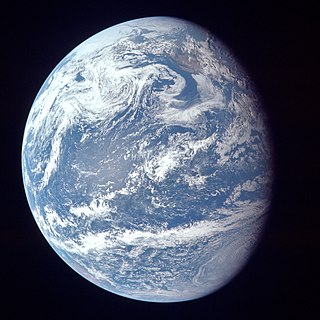
An ocean world, ocean planet, panthalassic planet, maritime world, water world or aquaplanet, is a type of planet that contains a substantial amount of water in the form of oceans, as part of its hydrosphere, either beneath the surface, as subsurface oceans, or on the surface, potentially submerging all dry land. The term ocean world is also used sometimes for astronomical bodies with an ocean composed of a different fluid or thalassogen, such as lava, ammonia or hydrocarbons. The study of extraterrestrial oceans is referred to as planetary oceanography.
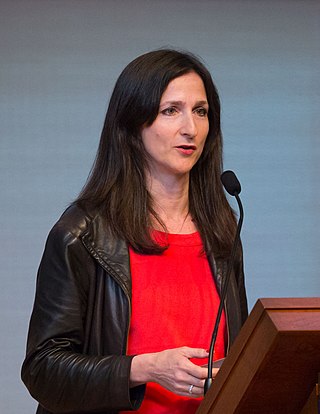
Sara Seager is a Canadian–American astronomer and planetary scientist. She is a professor at the Massachusetts Institute of Technology and is known for her work on extrasolar planets and their atmospheres. She is the author of two textbooks on these topics, and has been recognized for her research by Popular Science, Discover Magazine, Nature, and TIME Magazine. Seager was awarded a MacArthur Fellowship in 2013 citing her theoretical work on detecting chemical signatures on exoplanet atmospheres and developing low-cost space observatories to observe planetary transits.
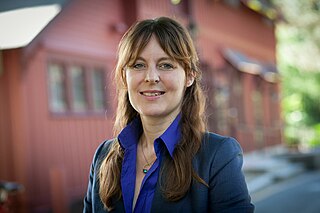
Lisa Kaltenegger is an Austrian world-leading astronomer with expertise in the modeling and characterization of exoplanets and the search for life. On July 1, 2014, she was appointed Associate Professor of Astronomy at Cornell University. Previously, she held a joint position at the Max Planck Institute for Astronomy in Heidelberg where she was the Emmy Noether Research Group Leader for the "Super-Earths and Life" group, and at the Center for Astrophysics | Harvard & Smithsonian in Cambridge, MA. She was appointed Lecturer in 2008 at Harvard University and 2011 at University of Heidelberg.

Technosignature or technomarker is any measurable property or effect that provides scientific evidence of past or present technology. Technosignatures are analogous to biosignatures, which signal the presence of life, whether intelligent or not. Some authors prefer to exclude radio transmissions from the definition, but such restrictive usage is not widespread. Jill Tarter has proposed that the search for extraterrestrial intelligence (SETI) be renamed "the search for technosignatures". Various types of technosignatures, such as radiation leakage from megascale astroengineering installations such as Dyson spheres, the light from an extraterrestrial ecumenopolis, or Shkadov thrusters with the power to alter the orbits of stars around the Galactic Center, may be detectable with hypertelescopes. Some examples of technosignatures are described in Paul Davies's 2010 book The Eerie Silence, although the terms "technosignature" and "technomarker" do not appear in the book.
The Virtual Planetary Laboratory (VPL) is a virtual institute based at the University of Washington that studies how to detect exoplanetary habitability and their potential biosignatures. First formed in 2001, the VPL is part of the NASA Astrobiology Institute (NAI) and connects more than fifty researchers at twenty institutions together in an interdisciplinary effort. VPL is also part of the Nexus for Exoplanet System Science (NExSS) network, with principal investigator Victoria Meadows leading the NExSS VPL team.
The Carl Sagan Institute: Pale Blue Dot and Beyond was founded in 2014 at Cornell University in Ithaca, New York to further the search for habitable planets and moons in and outside the Solar System. It is focused on the characterization of exoplanets and the instruments to search for signs of life in the universe. The founder and current director of the institute is astronomer Lisa Kaltenegger.
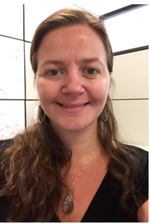
Tabetha "Tabby" Suzanne Boyajian is an American astronomer of Armenian descent and astrophysicist on faculty at Louisiana State University. She was a post-doctoral fellow 2012–16 at Yale University, working with Debra Fischer. Boyajian is active in the astronomical fields of stellar interferometry, stellar spectroscopy, exoplanet research, and high angular resolution astronomy, all particularly at optical and infrared wavelengths. She was the lead author of the September 2015 paper "Where's the Flux?", which investigated the highly unusual light curve of KIC 8462852; the star is colloquially known as Tabby's Star in her honor.
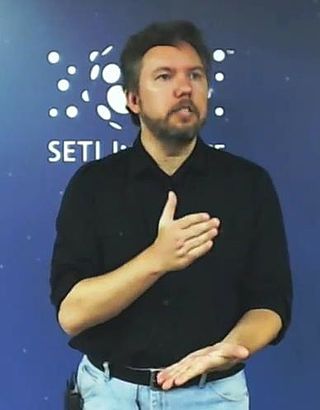
Stephen Kane is a full professor of astronomy and planetary astrophysics at the University of California, Riverside who specializes in exoplanetary science. His work covers a broad range of exoplanet detection methods, including the microlensing, transit, radial velocity, and imaging techniques. He is a leading expert on the topic of planetary habitability and the habitable zone of planetary systems. He has published hundreds of peer reviewed scientific papers and has discovered/co-discovered several hundred planets orbiting other stars. He is a prolific advocate of interdisciplinarity science and studying Venus as an exoplanet analog.

Betül Kacar is a Turkish-American astrobiologist and an Assistant Professor at the University of Wisconsin. She directs a NASA Astrobiology Research Center exploring the essential attributes of life, its origins and how they should shape our notions of habitability and the search for life on other worlds.
Sarah Hörst is an associate professor of planetary sciences at Johns Hopkins University, who focuses on understanding planetary atmospheric hazes, in particular the atmosphere of Saturn's moon Titan.

Antígona Segura Peralta is a Mexican physicist and astrobiologist. Since 2006, she has been a researcher at the Institute of Nuclear Sciences of the National Autonomous University of Mexico (UNAM) and collaborator at the NASA Astrobiology Institute. As a feminist she actively advocates for the inclusion of women in the exact sciences, mathematics, and engineering. Segura has participated in several activities in and outside UNAM defending women's rights; she was awarded with the 2021 Hermila Galindo medal by the Congress of Mexico City.
Nautilus Deep Space Observatory (NDSO) is a proposed deep space fleet of space telescopes designed to search for biosignatures of life in the atmospheres of exoplanets.
Large Interferometer For Exoplanets (LIFE) is a project started in 2017 to develop the science, technology and a roadmap for a space mission to detect and characterize the atmospheres of dozens of warm, terrestrial extrasolar planets. The current plan is for a nulling interferometer operating in the mid-infrared.

There are several methods currently used by astronomers to detect distant exoplanets from Earth. Theoretically, some of these methods can be used to detect Earth as an exoplanet from distant star systems.
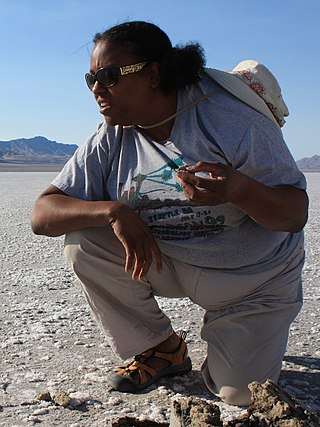
Kennda Lian Lynch is an American astrobiologist and geomicrobiologist who studies polyextremophiles. She has primarily been affiliated with NASA. She identifies environments on Earth with characteristics that may be similar to environments on other planets, and creates models that help identify characteristics that would indicate an environment might host life. Lynch also identifies what biosignatures might look like on other planets. Much of Lynch's research on analog environments has taken place in the Pilot Valley Basin in the Great Salt Desert of northwestern Utah, U.S. Her work in that paleolake basin informed the landing location of NASA's Perseverance Rover mission—at another paleolake basin called Jezero Crater. Jim Greene, Chief Scientist at NASA, called Lynch "a perfect expert to be involved in the Perseverance rover." Helping to select the proper landing site for NASA's first crewed mission to Mars in 2035 is another of Lynch's projects. Lynch has appeared in multiple television series, as well as The New York Times, Nature, Scientific American, and Popular Science. Cell Press designated Lynch one of the most inspiring Black scientists in the United States.

MERMOZ is an astrobiology project designed to remotely detect biosignatures of life. Detection is based on molecular homochirality, a characteristic property of the biochemicals of life. The aim of the project is to remotely identify and characterize life on the planet Earth from space, and to extend this technology to other solar system bodies and exoplanets. The project began in 2018, and is a collaboration of the University of Bern, University of Leiden and Delft University of Technology.
References
- 1 2 3 "Dr Sarah Rugheimer | Jesus College, University of Oxford". www.jesus.ox.ac.uk. Retrieved 2019-10-02.
- 1 2 3 "Interview with former graduate student Sarah Rugheimer". origins.harvard.edu. Retrieved 2019-10-02.
- ↑ Sarah Rugheimer | Harvard Horizons Symposium , retrieved 2019-10-02
- ↑ Friedlander, Blaine (15 June 2015). "Astronomers create array of Earth-like planet models". Cornell Chronicle. Retrieved 2019-10-02.
- ↑ Dorminey, Bruce. "How Astronomers Will Tease Life From Distant Exo-Earths". Forbes. Retrieved 2019-10-02.
- ↑ Witze, Alexandra (27 July 2016). "Planet Hunters Seek New Ways to Detect Alien Life". Nature. 535 (7613): 474–5. Bibcode:2016Natur.535..474W. doi: 10.1038/535474a . PMID 27466103. S2CID 4444935 . Retrieved 2019-10-02.
- ↑ "Earth holds the key to detecting life beyond our solar system". phys.org. Retrieved 2019-10-02.
- ↑ "Are there aliens out there? We are close to knowing for sure | New Scientist".
- ↑ "Dr Sarah Rugheimer wins Herschel Prize Lectureship | The Royal Astronomical Society". ras.ac.uk. Retrieved 2019-10-02.
- ↑ "Introducing: our 2019 Award Lecturers". British Science Association. 24 June 2019. Retrieved 2019-10-02.
- ↑ "The 2019 Barrie Jones Award Lecture | astrobiologysociety.org" . Retrieved 2019-12-08.
- ↑ "Meet the 2020 class of TED Fellows and Senior Fellows". TED Blog. 2020-01-23. Retrieved 2020-01-27.
- ↑ "Dr. Sarah Rugheimer". www.sarahrugheimer.com. Retrieved 2019-10-02.
- ↑ "Self-care with Drs. Sarah on Apple Podcasts". Apple Podcasts. 9 April 2019. Retrieved 2019-10-02.